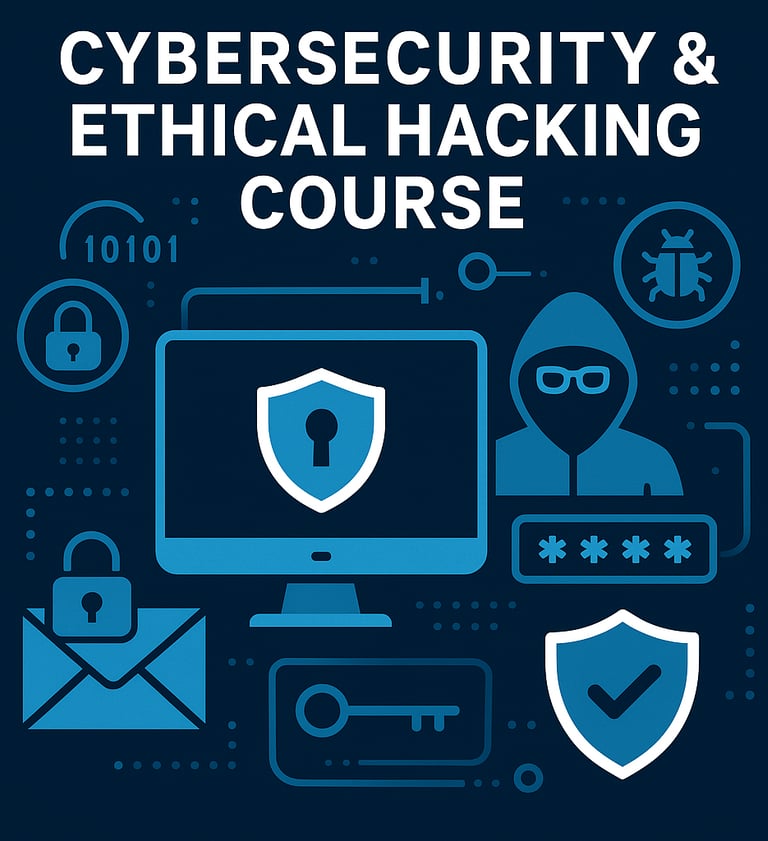Unlock the World of Ethical Hacking


Step into the shoes of a professional ethical hacker and learn how to secure systems, networks, and applications from real-world threats. Our hands-on course covers penetration testing, web and mobile app security, cloud security, and advanced hacking techniques—equipping you with the skills to think like an attacker and act as a defender.
Take the first step toward becoming a cybersecurity expert and shaping a safer digital future.
Who Can Join This Course?
Students and graduates aspiring to build a career in cybersecurity
IT professionals looking to upskill in ethical hacking and penetration testing
Developers, testers, and system admins who want to understand security risks
Career changers from non-IT backgrounds with a passion for cybersecurity
Prerequisites
Basic understanding of computers, operating systems, and networking
Familiarity with Linux/Windows commands is helpful (but not mandatory)
No prior cybersecurity or coding background required – we start from fundamentals and move to advanced concepts
What You’ll Gain After Completion
Hands-on Skills: Real-world experience in penetration testing, web/mobile security, API testing, cloud security, malware analysis, and more
Certifications: A course completion certificate that validates your cybersecurity expertise
Practical Knowledge: Training on industry tools like Burp Suite, Wireshark, Nmap, Metasploit, Nessus, and more
Portfolio Projects: Practical labs, case studies, and attack-defense simulations you can showcase to employers
Confidence to Hack & Defend: Learn to think like a hacker and protect like a professional
Job Assistance
We don’t stop at training—you’ll also receive:
Resume & Portfolio Building: Craft a strong cybersecurity profile highlighting your skills and projects
Mock Interviews: Practice technical & HR rounds to boost your confidence
Placement Guidance: Get connected with hiring partners and recruiters in the cybersecurity industry
Career Roadmap: Guidance on next steps—CEH, OSCP, or other advanced certifications
Syllabus
Module 1: Introduction to Cybersecurity & Key Concepts
Introduction to Cybersecurity
Definition, Importance, and Role of Cybersecurity in the Modern Digital Age
Types of Cyberattacks: Cybercrime, Hacktivism, Cyberwarfare o Ethical Hacking vs. Black Hat Hacking
Types of Hackers
Black Hat, White Hat, and Gray Hat Hackers
Script Kiddies, Hacktivists, and State-Sponsored Hackers
Ethical Hacking Guidelines CIA Triad
Confidentiality, Integrity, and Availability in Information Security
Importance of the CIA Triad in Vulnerability Management and Risk Assessment
Common Vulnerabilities and Exposure (CVE) & Identifiers
What is CVE? o CVE Impact and How It Affects Organizations
Understanding CVSS (Common Vulnerability Scoring System) and its Application
Types of Security Testing
Vulnerability Assessment (VA), Penetration Testing (VAPT), Red Teaming, Blue Teaming
Difference Between Automated and Manual Security Testing o Why VAPT is Critical in Cybersecurity
Module 2: Networking Fundamentals & Security
Introduction to Networks & Network Topology
Understanding Network Types: LAN, MAN, WAN o Network Topology and its Importance in Security
Key Network Devices: Routers, Switches, Hubs, Gateways, Firewalls
OSI Model and Network Protocols
OSI (Open Systems Interconnection) Model: Understanding Layers 1–7
Key Protocols at Each Layer (TCP/IP, UDP, HTTP, FTP, DNS, etc.)
TCP/IP Protocol Suite
How TCP/IP Works in Network Communication
Understanding IP Addresses, Subnetting, and Routing
TCP vs. UDP: Differences and Use Cases
Firewall: Basics & Monitoring o What is a Firewall and How Does It Protect a Network?
Types of Firewalls: Packet Filtering, Stateful Inspection, Proxy Firewalls
Firewall Protocols and Security Monitoring
Intrusion Detection System (IDS) & Intrusion Prevention System (IPS)
Role of IDS and IPS in Detecting and Preventing Attacks
Types of IDS: Signature-Based, Anomaly-Based, Hybrid IDS
Module 3: Linux Fundamentals and Security Tools
Kali Linux - Introduction o Overview of Kali Linux as a Penetration Testing Distribution
Practical: Kali Linux Setup and Command Line Basics
Linux File Permissions and Security o Understanding Linux File Permissions (Read, Write, Execute)
Practical: File Permissions, Sudoers, and User Management
Reconnaissance and Information Gathering
Practical: Network Reconnaissance Using Nmap
Practical: DNS Lookup and Using Google Dorks/Shodan for OSINT (Open Source Intelligence)
Social Engineering Techniques: Phishing
Practical: Port Scanning Using Hping3 and Nmap
Understanding Different Scanning Techniques: SYN, ACK, UDP Scans
Using Nmap for Network Discovery and Security Audits
Hping3 for Advanced Network and Port Scanning
Practical: Network Tools
Using Netcat for Banner Grabbing, Reverse Shell
Module 4: Vulnerability Scanning and Exploitation
Understanding Common Services/Protocols
Key Network Services: DNS, DHCP, HTTP(S), FTP, SSH, Telnet, etc.
Ipsec Protocols & Operations for Securing Communication
VPN Protocols: SSL/TLS, IKE o Practical: IKE Scan for VPN Discovery
Hacking Passwords
Types of Password Attacks: Brute Force, Dictionary, Rainbow Tables o Practical: Using Tools for Password Cracking
Vulnerability Scanning with Nessus
Introduction to Nessus: How to Perform a Vulnerability Scan
Understanding Vulnerability Reports and Risk Assessment
Introduction to Metasploit Framework: Setting up and Using Metasploit for Exploitation
Practical: Metasploit
Practical Exploits: Finding and Executing Exploits using Metasploit
Practical: Exploiting FTP, SMB, SSH
Module 5: Wireless Networks & Attacks
Wireless Networks Overview
Types of Wireless Networks (WEP, WPA, WPA2, WPA3)
Risks in Wireless Networks and Common Attack Vectors
Practical: Wireless Packet Interaction
Capturing WLAN Packets with Aircrack-ng, Wireshark
Cracking WEP Encryption and Cracking WPA/WPA2
Practical: Aircrack-Ng
Tools and Techniques to Crack WEP Encryption
Cracking WPA2 Using Dictionary Attacks
Evil Twin Attack
How Evil Twin Attacks Work and Mitigation Techniques
Practical: Setting up a Rogue Access Point for an Evil Twin Attack
Module 6: Web Application Penetration Testing
Introduction to Burp Suite as a Penetration Testing Proxy
Using Burp Suite for Intercepting and Modifying Web Traffic
Practical: Burp Suite
Common Web Application Vulnerabilities
Host Header Injection
Open Redirection
Cross-Site Scripting (XSS): Types of XSS (Reflected, Stored)
SQL Injection (Union and Blind Injection)
HTML Injection
Cross-Site Request Forgery (CSRF)
Insecure CORS (Cross-Origin Resource Sharing)
OTP Bypass
IDOR (Insecure Direct Object Reference) Attacks
File Upload Vulnerabilities
Parameter Tampering
Command Injection
XML External Entity
Access Control Issues
Path Traversal
Server Side Template Injection
JWT Attacks
OAuth Attacks
Lack of Rate Limiting
Module 7: Android Penetration Testing
Understanding the Android File System
Key Files in Android: Manifest, XML, DEX Files
Practical: Exploring Android File Structure and Filesystem
Android Pentesting Tools
Tools for Android Penetration Testing: MobSF, ADB
Using ADB (Android Debug Bridge) for Interacting with Android Devices
Dynamic Analysis - Memu
Practical: Configuring Memu to BurpSuite
Static Analysis
Practical: Decompiling/Reverse Engineer APK
Practical: Identify Vulnerabilities using Static Analysis
Practical: Exploiting Activity, Webview
Module 8: Reporting & Documentation
Penetration Testing Report
Importance of Documentation in Pentesting
Structuring Penetration Testing Reports: Executive Summary, Technical Details, Recommendations
Risk Assessment: CVSS Scoring and Impact Analysis
Submit Your Inquiries Below
Services
Training
About Us
info@evalpath.com
+91 9136 597384
© 2025. All rights reserved.
